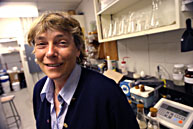Waste into want: rural innovations come to the city
Waste into want: rural innovations come to the city McGill University
User Tools (skip):
Waste into want: Rural innovations come to the city
Suzelle Barrington is on a mission to improve the economic value of agricultural wastes while decreasing their soil and water impact. The professor of Bioresource Engineering believes the lessons learned in rural areas can also be put to the test in the city, reducing the amount of urban waste destined for landfills.

Bioresource engineering professor Suzelle Barrington
Owen Egan
In collaboration with AgroDome Inc., a specialist in inflatable structures, Barrington has come up with a simple and cost effective solution to odour emissions from livestock operations. However, urban areas also face the challenge of disposing of vast amounts of organic waste. One way is composting, but up until now, that hasn't been an option in population-dense areas because of the smell associated with rotting waste. But Barrington's crusade against stink in all forms, wherever it occurs, could take the composting technology of the rural areas and bring it to the big city.
Current composting technology for livestock operations is time-consuming, complicated and inefficient, reducing the nutrient value of the fertilizer produced. The process requires oxygen-using bacteria, which create the acrid smell found in pig-farming country.
Now, with Barrington's inventiveness, storage facilities themselves can be transformed into anaerobic digesters, which work without oxygen, with the simple addition of a wastewater storage cover. These new storage/digestion units require very little in the way of attention, cost investment and technical knowledge to operate. Barrington points out that "the cover also conserves the nitrogen value of the manure, making it more economically valuable as fertilizer, while reducing the emission of greenhouse gases."
Barrington's research group is working together with the Éco-quartier Jeanne-Mance to create small composters appropriate for grocery stores and apartment buildings within Montreal. The benefits are twofold. They help reduce the amount of waste headed to a landfill site: 30 to 40 percent of household garbage is compostable. This saves on transportation and dumping costs, and the pollution associated with transport exhaust. Also, organic wastes can be broken down, making quite a nice fertilizer. In Barrington's world, one person's waste is another person's fuel.
The collaboration with Éco-quartier Jeanne-Mance is a two-step process. First, local businesses, such as restaurants and grocery stores, are being targeted. Soon a composter will be available for residents of the area. For urban composting to work, people must first sort their waste properly. Large, centralized composting sites often end up with contaminants like glass or metal. "To encourage people to sort their own waste, we felt that a composting site should be within view of the users. Producing compost for the users is incentive for them to collaborate on this project."
Currently, only 17 percent of Montreal garbage is recycled. According to Barrington, "composting could take care of 30 percent of waste, if everyone participates." A little effort on the part of everyone could provide the city and its residents with huge returns. Once the compost is "ripe," it would be distributed to participating residents for use as fertilizer. Compost is better for plant growth than synthetic fertilizers because it provides organic matter for the support of microbes as well as providing the minerals that plants need. Compost releases nutrients slowly over time, so it mimics more closely the natural state, with little risk of the chemical burn you can get with synthetic chemical fertilizers.
Homemade fertilizer could be used by the city in parks, reducing purchasing costs of fertilizer, and the rest could be sold for profit. Barrington hopes that other McGill researchers will get into the game and help develop special composting recipes, like mixtures for African violets, or tomatoes.
Barrington has also turned her attention to increasing the value of low-nutrient agricultural wastewaters, which can be used to irrigate crops. The use of wastewater to water crops is not a new idea, but now with Barrington's system, "the cost is one-fifth of what it used to be, while boosting crop yield." In the case of dairy farms, milk-house wastewaters must be disposed of year-round, even when the ground is frozen. When large volumes of water are dumped, "soil sealing" can occur, causing the ground to become impermeable and therefore useless for agriculture. Barrington stepped around this problem by developing a modified seepage system, in which wastewaters are distributed into the ground at a slow rate, reducing the risks of soil sealing and providing nutrients and moisture necessary for the crops to be grown in the summer season. Picture a long garden hose with holes punched in it, the water slowly trickling out. "Such systems are more beneficial than artificial wetlands," Barrington contends, "where contaminants simply accumulate, while the wetlands produce weeds of no value."
McGill's SPARK program (Students Promoting Awareness of Research Knowledge) is funded by NSERC and run by the Faculty of Education, VP Research Office and the University Relations Office. See Spark website.
